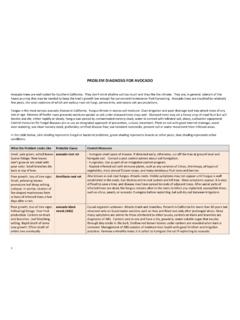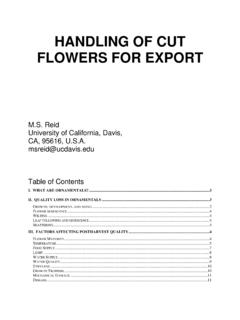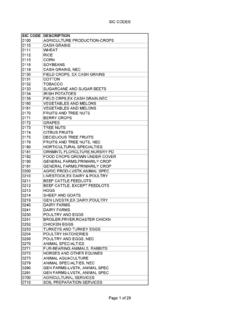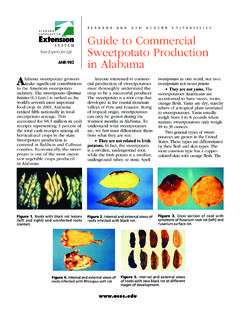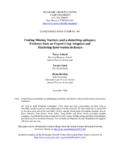Transcription of Postharvesttechnologyfordeveloping countries ...
1 Perspective Received: 27 October 2010 Revised: 13 December 2010 Accepted: 13 December 2010 Published online in Wiley Online Library: 26 January 2011. ( ) DOI Postharvest technology for developing countries : challenges and opportunities in research, outreach and advocacy Lisa Kitinoja,a Sunil Saran,b Susanta K Royb and Adel A Kaderc Abstract This article discusses the needs and challenges of developing good, science-based, simple methods for postharvest handling that can be made available in developing countries . Some of the traditional challenges have been successfully met ( identifying causes and sources of losses for key crops, identifying many potential postharvest technologies of practical use for reducing losses), but many challenges remain. These include the characterization of indigenous crops in terms of their unique postharvest physiology ( respiration rate, susceptibility to water loss, chilling sensitivity, ethylene sensitivity), ascertaining the differences between handling recommendations made for well-known varieties and the needs of local varieties of crops, and determining cost effectiveness of scale-appropriate postharvest technologies in each locale and for each crop.
2 Key issues include building capacity at the local level in postharvest science, university teaching and extension, and continued adaptive research efforts to match emerging postharvest technologies to local needs as these continue to change over time. Development of appropriate postharvest technology relies upon many disciplines that are relevant to the overall success of horticulture, plant biology, engineering, agricultural economics, food processing, nutrition, food safety, and environmental conservation. The expanding pool of new information derived from postharvest research and outreach efforts in these areas can lead in many directions which are likely to have an impact on relieving poverty in developing countries . c 2011 Society of Chemical Industry Keywords: capacity building; extension; fresh produce; fruits; postharvest losses; quality; safety; vegetables INTRODUCTION Physical and quality losses in turn lead to loss of market value, The primary goals of research on postharvest biology and concerns about food safety, and lower incomes for growers.
3 Technology of fresh produce are to reduce losses in quantity and While researchers have identified many potentially useful quality and to maintain safety between harvest and consumption postharvest technologies for use in developing countries , there is sites. The strategies for attaining these goals include: (1) growing a lack of information regarding the costs and financial benefits of cultivars that have good flavor and nutritional quality plus long these postharvest technologies, since costs are rarely documented postharvest-life potential when harvested at optimum maturity; during research studies. Generally the adaptive research step (2) using an integrated crop management system that maximizes between gathering laboratory findings and extension of the yield without sacrificing quality; and (3) using optimal postharvest results is missing or local costs are simply not considered when investigating the technology and its field applications.
4 Technically handling practices to maintain quality and safety of the food useful practices therefore tend to be disregarded since there is no products. Recent studies and literature reviews confirm that information on costs or their potential financial returns in different postharvest losses are still high at the farm, wholesale and retail developing regions. levels, and that not much improvement in the overall percentagof Although extension services in developing countries are losses can be documented from the 1970s to the present, despite increasingly involved in providing educational programs and active horticultural education and research programs in many training activities on postharvest topics, often there is a lack of countries . follow-through and support after the training. Those participating According to many studies, farmers have been losing between 30% and 40% of the value of their fruits and vegetables before they reach the final 8 These losses are observed at Correspondence to: Lisa Kitinoja, Horticulture and Food Security, World Food harvesting, during packing, transportation, in wholesale and retail Logistics Organization, 1500 King Street, Suite 201, Alexandria, VA 22314 USA.
5 Markets, and during delays at different stages of handling. In E-mail: Rwanda, Ghana, Benin and India, recent studies have generated a World Food Logistics Organization, Alexandria, VA 22314 USA. similar findings, with losses ranging from 30% to 80%.9 Physical and quality losses are mainly due to poor temperature management, b Amity International Centre for Postharvest Technology and Cold Chain use of poor quality packages, rough handling, and a general lack of Management, Amity University Uttar Pradesh, Noida 201 303, Uttar Pradesh, India education regarding the needs for maintaining quality and safety 597. of perishables at the producer, wholesaler, and retailer c Department of Plant Sciences, University of California, Davis, CA 95616, USA. J Sci Food Agric 2011; 91: 597 603 . c 2011 Society of Chemical Industry L Kitinoja et al. in postharvest training may be convinced and willing to implement practical to completely eliminate postharvest losses, an acceptable improved practices, but cannot do so when needed supplies, tools loss level for each commodity and production area combination or equipment are not locally available.
6 Even when users are initially can be identified on the basis of cost benefit analysis (return on provided with these tools and supplies as part of a training program investment determination). Since energy use is such an important or development project, there tends to be a lack of local support component of relevance and practical applications for postharvest and services once the programs end. Any adoption of changes technologies for users in developing countries , it is important in postharvest practices are then abandoned as repairs cannot to consider the availability and cost of energy when assessing be made when facilities, coolers, equipment or handling systems ,22 Future postharvest research needs to build on existing break down and tools or spare parts cannot be obtained locally or knowledge, and be adaptive, applied, and suitable for small-scale at reasonable cost. users. A systematic analysis of the production and handling system for each commodity is the logical first step in identifying an appropriate strategy for reducing postharvest losses.
7 Also, it is CHALLENGES AND OPPORTUNITIES IN essential to determine the return on investment in each of the selected postharvest technologies. Scale is important because POSTHARVEST RESEARCH AND OUTREACH most farmers in developing countries operate on a small scale, Less than 5% of funding for horticultural research and extension both in terms of land area in production, and in the low volumes of (R&E) has been allocated to postharvest issues over the past crops harvested and handled on any given day. Such information 20 years,10,11 as the historical focus has been on increasing can greatly facilitate convincing handlers and marketers of the production. In the 1990s the focus moved to marketing and more value of adopting the recommended technologies. recently to value chain development. Still, Internet databases Just a few examples of current research needs are local show that less than 1 in 2000 agricultural projects undertaken postharvest loss assessments, studies of reusable/recyclable globally have focused on fresh produce handling and marketing, packages, inexpensive and safer ripening systems, low-cost according to advanced searches during 2009 using AiDA,12 USAID cooling methods, sanitation and food safety practices, bio- DEX,13 World Bank Documents,14 UNFAO inPHo,15 and DEVEX pesticides, and alternative energy sources for postharvest uses.
8 While thousands of development projects have been Developing countries are tackling environmental issues in various launched in developing countries between 1990 and the present ways, some of which will likely affect postharvest research. For time by dozens of donor agencies, few have focused on agriculture example, a bill was passed in 2006 in Rwanda that banned the use of (less than 6% according to the AiDA database; 25% according plastic bags. Alternative packaging materials for horticultural crops to the World bank), very few have focused upon horticulture therefore need to be studied and locally assessed for feasibility and (approximately 1% of the agricultural projects), and only 1/3 cost effectiveness. Possibilities include the use of cassava-based of these very few horticultural projects included a postharvest polymers, chicken feather polymers, or bio-degradable non-food component.
9 Postharvest' designations, when investigated further starches. in these databases, generally turned out to be some kind of food Capacity building in postharvest research is an obvious need in processing. Most of the other horticulture projects appeared to many developing countries and can be achieved via internships, focus upon increasing food production via various means such as faculty exchanges, human resource development for staff in improving irrigation systems, infrastructure projects, developing university laboratories and research centers, laboratory upgrades, markets for processed or export products or strengthening improved access to web-based information, and mentoring. capacity in extension work. Leadership training is an important component in capacity building and, while it has been well characterized, is often Although there are a few researchers in each RESEARCH ACHIEVEMENTS AND NEEDS developing country who carry out some postharvest research, Although the biological and environmental factors that contribute there tends to be very little coordination among the postharvest to postharvest losses are well understood and many technologies researchers within each country or among countries within each have been developed to reduce these losses,17 19 they have region.
10 Also lacking is interdisciplinary collaboration among not been implemented, in many cases, due to one or more of production horticulturists, plant pathologists, entomologists, the following socioeconomic factors: (1) inadequate marketing marketing economists, engineers, food technologist, consumer systems; (2) inadequate transportation modes; (3) unavailability of scientists, and others who may be involved in various aspects needed materials, tools, and/or equipment; (4) lack of information; of the production and marketing systems. Such cooperation and and (5) governmental regulations and legislations. Mrema and collaboration are essential to establishing effective research and Rolle20 reported that priorities within the postharvest sector of extension programs. developing countries have evolved from a primarily technical focus Although much of the information needed to properly handle geared towards the reduction of losses, to a more holistic approach foods of plant origin is known, there is a need to refine the designed to link on-farm activities to processing, marketing requirements and recommendations for the particular cultivars and distribution.



